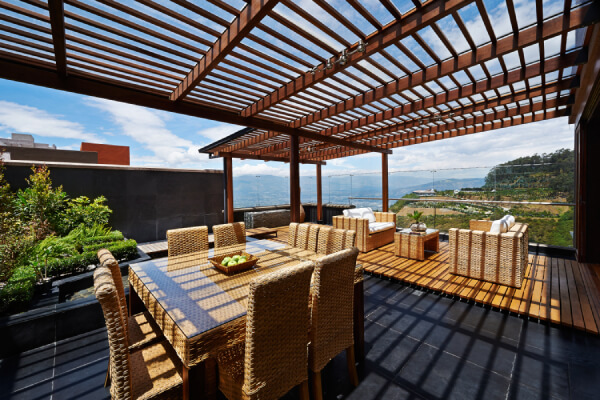
How Much Does It Cost to Build a Shed – Full Breakdown 2025
Imagine having a place that’s only a few steps away from your back door, that can be dedicated to your creative space. Building a shed can be a great addition
This is Not a Legal Survey


Contributing Writer | Architecture & Design Writer
Imagine transforming your backyard property into an oasis and creating the perfect relaxing spot for you, and your family. Well, in this text, we’ll help you make it happen, and introduce you to the permitting process of obtaining a pergola permit for your pergola project.
Understanding the building permits, process, and pergola code requirements can help you design your outdoor space in the best possible way, so stay with us, and let’s explore the secrets of crafting your very own place, one permit at a time!
Table of Contents
Toggle
The answer to this question is in most cases yes (for freestanding pergolas and for pergolas attached to the house). In order to determine whether you need a permit for a pergola, you need to contact your local building or zoning department to get specific information regarding permits for pergolas in your area.
In many areas, more diminutive and freestanding pergolas without roofs don’t need a permit to build a pergola, but bigger and more complex outdoor structures, especially the ones with roofs and electrical features, always do require a permit.
You will need a site plan as well, to show your pergola’s precise location on your property.
The average price of a building permit for pergola costs from $50 to $150. The cost depends on your location, the size of the pergola, and district regulations. Building permit fees are typically determined by the permitting authority.

Homeowners should always consider 2 things when obtaining a pergola permit:
The rules and regulations for obtaining a building permit for a pergola vary from one place to another, but here are some steps that you need to follow when obtaining a permit for a pergola:
Once you get your building permit and documents approved, you can start building your pergola. Always be sure to follow all the approved plans, consult with a professional contractor for any doubts, and check in with the homeowner’s association.
When obtaining a pergola permit, homeowners should always consider an HOA permit and approval.
Many homeowner’s associations have their specific approval processes for exterior improvements and construction, and because of this, it’s necessary to seek approval from your homeowner’s association before applying for a permit.
HOAs also have their own rules regarding the design, colors, and materials of structures like pergolas. They can also charge additional fees for architectural reviews and approvals for your pergola project.

Constructing a pergola without a building permit can result in many issues, including:
To avoid these types of problems, it’s always advisable to check local regulations before starting a pergola construction. Continue reading and find out everything you need to know about pergola building codes.

The biggest confusion when it comes to building a pergola are different codes. There are state codes, county codes, and city codes, and the question is which code to adhere to. The correct answer is that you should stick to the most local one.
This means that you should call your local building inspector or local government agency with all possible questions or concerns you have. When building a pergola, you need to keep in mind that building codes vary by location, and they typically include regulations on building materials, height, and setback requirements, as well as fire codes.
Let’s find out what is in a building code for a pergola so that we can fully understand the process of obtaining a pergola permit.

Here are some of the most common factors that are often found in building codes for a patio cover or pergola:
In order to ensure compliance with local building codes and regulations for a specific location, it is crucial to contact your building municipality or a qualified professional for local building requirements. A professional can provide the best construction information for your pergola construction project.
You can construct a smaller pergola, typically up to 100-200 square feet, without needing a building permit.
Yes, pergolas are generally considered permanent structures. Pergolas are usually designed with durable materials like wood, metal, or vinyl and they are constructed to withstand all types of weather conditions. Although they don’t have a solid roof, they are fixed in place and are not meant to be easily removed.
The time that is necessary for obtaining a pergola permit varies by location. In some areas, it can take a few weeks, while in others it could extend to several months.
In many cases yes, it’s possible to apply for a pergola permit after you’ve already built the whole structure, but it can also be much more complicated and may have potential consequences. Building a pergola without permission can result in fines, stop-work orders, or even requirements to remove the structure.
If you make any changes to your pergola design after the permit is approved, it’s essential to contact your local building department to inform them of the changes you made. Depending on the change you made, you will probably need to pay some extra fees and there will be an inspection to ensure the alterations meet all safety standards.
Yes, they have expiration dates. Pergola permits are typically issued with an expiration date, which is several months to a year from the date of issue.
Obtaining a pergola permit can sometimes seem complicated, but although the process requires some effort, in the end, you’ll be able to enjoy your personal outdoor space paradise with a legal, worry-free outdoor addition of a pergola that can last for years.
Permitting process exists for your safety, the easiest way to make the process quicker is by ordering a site plan for permits. Our team will make it and deliver it to you in 24 hours or less.
If you want to add any other additions to your property, like a deck, our article on Deck permit might help you.
Learn more about our contributor:

Contributing Writer | Architecture & Design Writer
During my career, I’ve written articles on interior design, home remodeling, and renovation with an emphasis on money-saving tips and DIY ideas. It’s been a rewarding journey and I am thrilled to continue helping others bring their architectural visions to life.

Imagine having a place that’s only a few steps away from your back door, that can be dedicated to your creative space. Building a shed can be a great addition

Building a deck is a great way to transform your outdoor space into a more appealing and functional area for relaxation and entertainment. To ensure the deck’s safety and durability,

Are you looking to modernize your pool with an outdated design and want to improve its functionality? If so, you’re in the right place. Imagine transforming your basic swimming pool